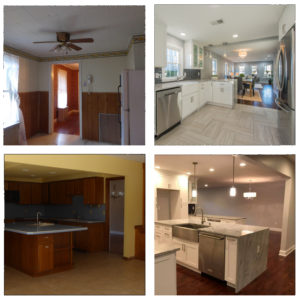
Have you ever thought about making your home “more open”? Older homes tend to have smaller compartmentalized rooms making it difficult to circulate and give the occupant a sense of claustrophobia. How can you gain space in your home or make your kitchen larger by not creating an addition? Well, the first step is to reach out to an architect to discuss your thoughts and desires. An architect can visualize the space and identify problems that may occur or inform you of the best approach.
However, when doing any renovation project there are many hidden conditions, some predictable and others not. When an architect starts such a project he/she will need to measure your home and pay special attention to the area being addressed for your project. He/she will take a look in your attic and gather dimensions and the direction of roof rafters as well ceiling joists above the second floor (if you have a second floor) and the room dimensions and all the features associated within these areas. In addition to measuring the main floor, the architect will also survey the basement for additional information, such as column locations, girders and floor joists (sizes and direction of spans). If you have a finished basement and the structure is not visible this will be a very difficult task and may need to be re-looked at once you secure a general contractor who would open up the walls to discover what’s existing. The architect also gathers floor to floor dimension to try and surmise what the floor joists actually are. Let’s say he measures a distance of 8’-10 ½” from floor to floor and your ceiling height is 8’-0” one can safely assume a 2×10 floor system is within the floor-ceiling assembly. This is important to know if you would like the new opening between rooms to just flow without any interruption within the ceiling like a soffit hanging down. The architect will size a beam that can be installed flush to the ceiling. If a detail like this is not critical the beam can always be placed below.
Why does the architect measure the rooms above and below? Above we need to know what types of loads are coming down on the new opening. Are there any point loads coming from a doorway or a post from the attic supporting the roof? It must also be determined the amount of square footage of floor area is being placed on this opening. Why below? Similarly, the architect will see if the structure in the basement is adequate or new columns, beams and even footings need to be installed. The footing is very tricky because that is not possible to know what is under the concrete floor holding up your existing home, so when the general contractor starts work, he will need to cut some holes to determine what is existing and if remediation is required to conform with the architect’s drawings. Some building officials in different towns want this information up front before they even issue a permit so always be prepared for an unexpected cost, whether during or prior to construction!
In the end, you are going to be so pleased to have opened up your home despite some of the inconveniences along the way. Your home will become a new destination for friends and family to gather, circulate and enjoy without being closed in!


